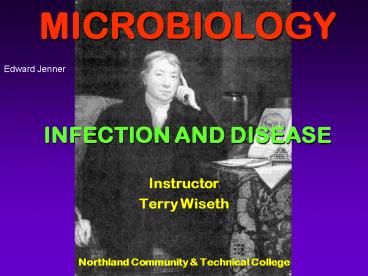MICROBIOLOGY INFECTION AND DISEASE - PowerPoint PPT Presentation
1 / 34
Title:
MICROBIOLOGY INFECTION AND DISEASE
Description:
Acute stage of Small pox infection. 15. STAGES OF ACUTE DISEASE ... Chicken Pox Scar. 16. STAGES OF ACUTE DISEASE. 5) Convalescence. The body returns to normal ... – PowerPoint PPT presentation
Number of Views:202
Avg rating:3.0/5.0
Title: MICROBIOLOGY INFECTION AND DISEASE
1
MICROBIOLOGYINFECTION AND DISEASE
Edward Jenner
- Instructor
- Terry Wiseth
- Northland Community Technical College
2
POPULATIONS OF MICROORGANISMS
- The number of organisms at a site is determined
by - The amount of oxygen
- pH
- Other organisms
- Nutrients
- Immune response of thehost
- Availability of receptors for organisms
3
SYMBIOSIS
- Interaction between 2 organisms
- Mutualism - Both benefit
- Commensalism - One benefits while the other,
neither benefits nor is harmed
4
SYMBIOSIS
- Synergism - Together both can accomplish what
neither can achieve alone - Parasitism - One benefits and causes harm to the
other
5
PATHOGENICITY
- Colonizer
- Organism that live with a host without causing an
immune or allergic response - Pathogenic
- Organisms that cause disease
6
VIRULENCE
- a quantitative measure of pathogenicity
- measured in
- Infectious dose (ID50)
- the number of organisms that will cause disease
in 50 of test animals - Lethal dose (LD50)
- the number of organisms that will cause death in
50 of test animals
7
ATTENUATION
- Loss or reduction of virulence
- Organisms can be treated with agents to achieve
attenuation in order to be used as vaccines
8
CARRIERS
- Some individuals can be infected by a pathogen,
but show no symptoms
Typhoid carrier Rosina Bryans was held in an
insane asylum for 60 years even though never
insane
9
SYSTEMIC
- Organisms spreading through the body
Systemic Staph Infection
10
TYPES OF DISEASES
- Chronic disease
- microbial persistence in the host
- with symptoms over a long period
TINEA PEDIS ATHLETES FOOT
11
TYPES OF DISEASES
- Acute disease
- Symptoms appear quickly
- become intense and subside when the host's immune
system disposes of the pathogen and toxic products
MORBILLIVIRUS causative agents of measles
12
STAGES OF ACUTE DISEASE
- 1) Incubation
- From the time organisms enter the hosts until the
first symptoms appear
Open Wound not currently infected
13
STAGES OF ACUTE DISEASE
- 2) Prodromal
- Symptoms indicate the onset of disease
- e.g. Malaise, headache, fever, etc..
14
STAGES OF ACUTE DISEASE
- 3) Acme (Acute)
- Symptoms are at their peak and there is an immune
response by the host
Acute stage of Small pox infection
15
STAGES OF ACUTE DISEASE
- 4) Period of decline
- A recovery period with the decline of symptoms
and, their is maximum antibody levels in the host
Chicken Pox Scar
16
STAGES OF ACUTE DISEASE
- 5) Convalescence
- The body returns to normal
17
SOURCE OF DISEASE
- For organisms to be pathogenic they require
- a site to maintain their ability to infect and
replicate - Such a place is called a Reservoir
- The object, place or person from which organisms
pass to the host is called the Source - Sometimes reservoir and source are the same
18
HUMAN SOURCE
- Convalescent carriers
- are recovering from a disease
- Healthy carriers
- do not show symptoms of the disease but harbor
the organisms
19
ANIMAL SOURCE
- Zoonosis
- e.g. Rabies, Plague
20
INSECT SOURCE
- Mechanical vectors
- Organisms are carried on the appendages of the
insect
21
INSECT SOURCE
- Biological vectors
- Insects are the reservoir of the organisms and
transmit them to humans or animals - Insects are required for at least part of the
developmental cycle of the organism
Malaria is dependent on part of its development
in the gut of the mosquito
22
INANMIMATE RESERVOIR
- Soil, water and food
- Spores can be inhaled, then germinate, multiply
and produce disease
Anthrax is inhaled to the alveoli where they
germinate and cause disease
23
INANMIMATE RESERVOIR
- Some bacteria that produce harmful toxins are
indigenous to the soil - e.g. Clostridium
- Pathogens can be passed into water and live in
fish and shell fish - Food is a reservoir for agents infectious to man
24
TRANSMISSION OF INFECTIOUS ORGANISMS
- contact
- water
- food
- fomites
- air
25
CONTACT
- Direct
- From person to person by close association
- e.g. kissing, sexual contact, sneezing etc..
26
CONTACT
- Indirect
- From one person to another through intermediates
such as food, dust, water or fomites
27
WATER
- can be fecally contaminated
- Besides drinking, water borne pathogens can also
enter the body through sweat glands, abraded skin
etc..
28
FOOD
- Analysis must confirm the food as the source of
the disease - Factors that contribute to food infections are
- Improper storage temperatures
- poor hygiene
- contaminated equipment
- inadequate cooking
29
FOMITES
- Inanimate objects, other than food and water
- e.g. Catheters, needles etc..
30
AIR
- not a reservoir but is a means of transmission
- e.g. coughing and sneezing
31
PATTERNS OF DISEASE
- Endemic
- A continuous subepidemic level of disease in a
specified community - Outbreak
- A slight increase in the level of disease over
endemic level
32
PATTERNS OF DISEASE
- Epidemic
- A large number of new cases of a disease, in a
defined time, above the endemic level
33
PATTERNS OF DISEASE
- Pandemic
- World Wide epidemics
- Sporadic
- Disease occurs in an irregular pattern therefore
no frequency can be calculated
34
ENDINFECTION AND DISEASE































